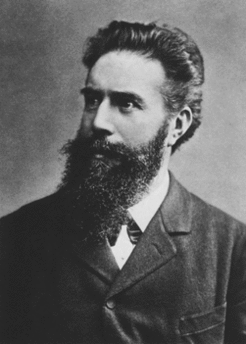Wilhelm Conrad Röntgen

Courtesy Deutsches Museum München.
Wilhelm Conrad Röntgen (b. March 27, 1845, Lennep, today part of Remscheid - d. February 10, 1923, Munich), German physicist, who was the recipient of the first Nobel Prize for Physics, in 1901, for his discovery of X-ray's. Röntgen was professor of physics at the universities of Hohenheim (1875), Straßburg (1876-79), Gießen (1879-88), Würzburg (1888-1900) und Munich (1900-20). His research also included work on specific heats of gases, absorption of heat by gases, capillary action of fluids, elasticity, conduction of heat in crystals, and piezoelectricity. On November 8, 1895, while experimenting with a cathode-ray tube, Röntgen observed a new kind of rays which travelled through paper, wood, and aluminum and which he called X-radiation, which also became known as Röntgen radiation.
A detailed biography can be found at the Nobel Foundation.
The ROSAT (Röntgensatellit) was named in honor of Wilhelm Conrad Röntgen.
1995 marked the 100th anniversary of his discovery of X-rays and was celebrated with a conference.
The Kuratorium zur Förderung des Andenkens an Wilhelm Conrad Röntgen in Würzburg e.V. maintains a Röntgen memorial (in German) in the former Physikalischen Institut der Universität Würzburg, which today the Polytechnic Würzburg-Schweinfurt-Aschaffenburg is domiciled.
The German Röntgen Museum is situated in Remscheid.
